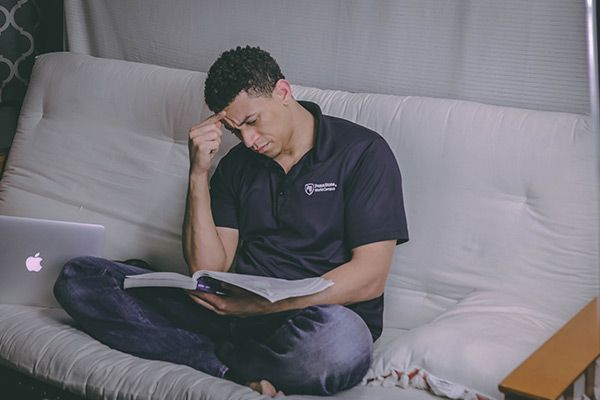Welcome back to the Healing Pain Podcast with Javier Martinez-Calderon, PT, PhD
As always, it’s a great pleasure and honor to be spending this time with you. In this episode, we’re discussing the role of positive psychological factors and the association of chronic pain with a specific emphasis on pain acceptance, pain self-efficacy and optimism. My expert guest is Dr. Javier Martínez-Calderón. Javier is a Spanish pain researcher and a physical therapist who completed a PhD in which he explored how psychological factors impact people with chronic shoulder pain. He’s an Assistant Professor at the Universidad of Sevilla, Spain and a pain researcher in the Biomedical Research Institute of Malaga. His postdoctoral research is focused on the role that cognitions and emotions play in people with chronic pain.
In this episode, you’ll learn all about the importance of positive psychological factors, and how they impact recovery for people with chronic pain with a specific emphasis on pain acceptance and pain self-efficacy. If you’re interested in learning more about pain acceptance, make sure to check out my book called Radical Relief: A Guide to Overcome Chronic Pain, which is based on the principles of acceptance and commitment therapy. You can order it on Amazon. Without further ado, let’s begin and let’s meet Dr. Javier Martínez-Calderón and learn all about how psychological factors impact chronic pain.
—
Watch the episode here:
Subscribe: iTunes | Android | RSS
The Role Of Pain Acceptance, Pain Self-Efficacy And Positive Psychological Factors In The Treatment Of Pain With Javier Martinez-Calderon, PT, PhD
Javier, welcome to the show. It’s great to have you here.
Hello, Joe. Thanks for inviting me. I was looking forward to having this interview. I appreciate it.
I’m excited to talk to you. I came across some of your research and it’s interesting. It talks a lot about the things that we speak about on this show and aspects of what else many physiotherapists and other health professionals are talking about with regard to the biopsychosocial approach to pain. We’re going to talk a lot about a paper that came out and I want to let everyone know the name of the paper. It’s called, The Role of Positive Psychological Factors in the Association Between Pain Intensity and Pain Interference in Individuals with Chronic Musculoskeletal Pain. It’s in the 2020 Journal of Clinical Medicine so we’re going to go through some of those details which will be important for practitioners who treat pain as well as so people understand what’s happening with regards to pain. You started your career out as a physiotherapist. How did you become interested in the mind, brain, cognition, memory, mood and all the things you’re studying?
This is a specific question for me because I had persistent low back pain for several years with strong episodes of pain. I can remember some situations where the pain paralyzed me. Unprovoked that I couldn’t do anything to stop the pain. For example, I had persistent low back pain when I was going down any step and the situation caused me to often have rumination and hypervigilance when a step was close. I noticed that when I was anxious, worried, frustrated, or something, the intensity of the pain was worse. Indeed, I realized that I commonly use passive coping strategies to manage that pain such as being hypervigilant or pain avoidance.
However, I achieved to get out of this negative circle. I started to practice yoga several years ago, mindfulness, and different types of meditation. With this, I started to connect my mind with my body and build not only pain self-efficacy but also other psychological factors in a productive way. For example, pain acceptance and psychological flexibility. This process permitted me to tolerate the uncertainties associated with my pain process and develop coping strategies to manage my pain better. I am happy now because I can say that I have no lower pain anymore.
You’re paying for it which is interesting, because so often people wonder, “Can I stop the pain? I eliminate the pain. Can I get out of pain?” You’re saying, through your experience, you’re able to do that. I’m curious, when you develop chronic low back pain, were you a physiotherapist at that point?
Yeah. I finished my degree in physical therapy in 2015. When I started to work as a physical therapist, I could observe not only with a patient but also with myself as a patient that a difference in strategies doesn’t work. The biomedical strategy doesn’t work in this case. For example, when I worked as a physiotherapist, I applied this intervention sometimes but people with persistent pain are responding in a completely different way. Although they present me with the same pain level, for example, Subacromial Pain Syndrome, the deviance to some intervention such as exercise therapy was difficult in some cases. On the other hand, other patients responded perfectly well. For example, they presented higher levels of pain self-efficacy.
I could see the frustration and the expectations, not only with the patient but with myself too. When I came to physiotherapy, I wanted to know how the brain works, what conditions and emotions could be involved in why some people do exercise and others not? Why people with persistent musculoskeletal pain differently perceive, interpret, and manage their pain. This information is useful for physical therapists in order to not only improve therapeutic alliance but also the adherence of the patients in the clinical practice.
Your PhD work focused on emotion if I remember correctly?

I did my PhD about the role that psychological factors play in people with chronic shoulder pain. I did my PhD in Cotutelle between the University of Malaga in Spain and at the University of Antwerp in Belgium. During my PhD process, I moved around not only with chronic shoulder pain but also in chronic musculoskeletal pain. This is my post research line. I could share my PhD with a great expert in shoulder pain. For example, Dr. Alejandro Luque-Suarez of the University of Malaga, and Dr. Filip Struyf and Dr. Mira Meeus at the University of Antwerp.
Also, I have the opportunity to share a beautiful project in muscle pain disorders and chronic pain with Dr. Deborah Falla and Dr. Umar Johnson. Apart from the conceptual line of work, cognition and emotions related to pain, my other research line my passion is related to mythology, specifically with the development of systematic reviews, because I feel that we live in the era of information. I believe that researchers must facilitate a substantial quantity of knowledge to pain, in order to have all the access, only one paper is important to this. For that reason, our research group is focused on continuously in the development of multiple systematic reviews in this field.
I love a good systematic review because it brings things together nicely and you don’t have to spend hours and sometimes weeks digging for information. For those of us who read research, that’s important research. Let’s shift and let’s talk about your paper. As I mentioned, people can access it but the focus of the paper is the role of positive psychological factors in the association between pain intensity and pain interference. It’s a little technical, but we’re going to break it down for people so they understand it in a way that’s simple, but the best place to start is why did you decide to study this topic? Why was it important?
Most people know that persistent pain is multifactorial. Many factors, cultural, contextual, biological, social, psychological, or biomechanical, could be involved in the pain experience. I see persistent pain as a stressor. Unlike any stressors in our lives, our beliefs, thoughts, and emotions are involved. For that reason, despite the presence of multiple factors in the pain experience, personally, psychological factors, specifically beliefs, thoughts, and emotion could be key factors in the perception, modulation and coping with our pain.
Our research group has explored different conditions and emotions related to pain, but we are interested in evaluating the role that protected cognitions and emotions play in the perpetuation of musculoskeletal pain. There is so much evidence in the last two decades or so in analyzing the importance of negative psychological factors. Think about suffice, imperative fear, phobia. However, factors such as optimism, pain resilience, pain acceptance, or pain-related self-esteem have not been investigated.
That’s what I liked about your paper and there’s been so much pain catastrophizing, I feel like we have enough information there. We all understand that we all get it. Even people with chronic pain know the word pain catastrophizing now. That message has landed well with people. The three that you mentioned that you’re talking about in your paper, which are positive psychological factors, and I like that too. Oftentimes, these three are not described as positive psychological factors so it’s important that we describe them like that. They were pain acceptance, pain self-efficacy, and optimism. Can you describe what each one is or maybe give us a small definition of what each one is?
The three concepts are cognitions. Self-efficacy is a broad concept, which involves different types of self-efficacy, for example, exercise self-efficacy or pain self-efficacy. It’s important to understand this because when researchers assess self-efficacy, we need to focus on one type of specific type of self-efficacy. In this case, pain-efficacy is the belief that I can do different kinds of things, movement activities, and achieve the desired outcome. This is a good concept to promote, for example, the adherence of our patients in your clinical practice.
There’s a difference between general self-efficacy that we often see in the literature because that word is used a lot versus there’s something specific, which is in your paper pain self-efficacy.
It’s important. We have different patient-reported outcomes to measure different kinds of self-efficacy. Another one is pain acceptance. Pain acceptance for me, one of the gold standard protective factors, because it’s a concept that is included in a broad concept, the Psychological Flexibility Model proposed by Lance McCracken. It’s important to have a distinction between acceptance and resignation in people with persistent pain because when I accept a situation, in this case, a stressor, a pain, I have the opportunity to tolerate the uncertainties about the pain process. Imagine that you do not accept your pain and you have resignations about your pain. You don’t like to practice exercise. You use passive coping strategies and sedentary behaviors to move around out of your pain. It’s important, this distinction between pain acceptance and pain resignation.

You mentioned that pain acceptance is a gold standard and I missed the one thing you said.
Most people with persistent pain are about this process. Acceptance, self-esteem, and self-efficacy are probably my gold standard factors to promote endurance, therapeutic alliance and physical therapy.
The third one, the final one is optimism.
Optimism is a personality trait but could be considered as cognition. It’s the hope that all the things about our future could be great, but optimism is problematic. There is no specific pain tool to measure optimism related to pain now. Probably we will discuss this problem in our results.
It’s great to go through those three important things for people to think about. A part of this paper, what you explored is to research terms mediators and moderators. They’re important because we have to understand those to understand what the outcomes of your paper were. Can you describe what a mediator and a moderator is with regard to research and how it relates to pain intensity and pain interference in your paper?
One thing to understand about mediators and moderators is to consider these as factors in the middle of the one relationship between, for example, pain-related disability or pain interference. When we use a factor as a mediator, we are trying to explain a complete relationship between two factors. For example, imagine that pain self-efficacy is a complete mediator of the relationship between pain intensity and pain interference. This means that if I quit pain efficacy from the equation, the relationship between pain intensity and pain interference doesn’t exist. This is the complete definition of mediation. For the moderator, pain intensity and pain interference are related to each other, but a third factor can explain that this relationship is higher or lower in intensity.
Tell us what your outcomes were when you looked at these three factors of pain acceptance, pain self-efficacy, and optimism with regard to pain interference.
Why did I choose these factors?
No. Once you completed the study, what were the outcomes? What did you discover from the study?

Our main outcome was pain interference. We believe that in people with persistent pain, many times the main problem is not the pain itself, but also the consequences associated with that pain and the difficulty to develop a normal life for many patients with persistent pain. Despite the importance of the main anchor, pain interference, we have so much interest in exploring the protective cognitions that we included as mediators, moderators, optimism, pain acceptance and pain self-efficacy. We recognize and we know that all the relevant protective cognitions and emotions could be involved like happiness, psychological flexibility, pain resilience, and pain-related self-esteem among others. These factors have been shown to be relevant to chronic pain patients. We will probably investigate them in future studies.
Were all three equally important or out of those three were there some that were more important than others when you looked at the data?
It was surprising to find the lack of mediating effects of optimism in the association between pain intensity and pain interference because there is evidence supporting the importance of optimism in the reduction of pain and disability in musculoskeletal pain. However, at this point, it could lead to a discussion about how cognition and emotions should be assessed in chronic pain. In our study, pain acceptance on pain self-efficacy when assessed with specific pain tools but there is no pain tool to measure optimism related to pain.
The instrument commonly used to evaluate optimism is their life orientation is revised which evaluates optimism, as a global factor, but does not include specific pain questions about optimism related to pain. I encourage researchers to develop an instrument that includes questions assessing hope in a future in which they may be present but manageable. It’s essential to assess optimism in individuals who are in pain. Additionally, the lack of moderator effects for any psychological measure in our study, to think about the importance to consider all the relevant factors in the process. Most importantly, if we need to dry our effort to evaluate cognitions and emotions in a different way, for example, using qualitative interviews more than patient-reported outcomes.
Optimism, we think it’s important but based on your study, if we had a better tool to measure it, we would have a better idea of how much weight it carries in the recovery process, let’s say.
We are trying to extrapolate all the concepts of traditional psychology to the pain field, but there is so much concept, for example, self-esteem and optimism that we have no specific pain tools to measure these concepts.
From your research and some other research as well, if professionals target let’s say pain, self-efficacy, and pain acceptance, that’s a good place for them to start working with people with regard to the psychosocial factors. Would you say that’s true?
Although optimism was found to show a lack of mediating effects, pain acceptance, and pain self-efficacy were found to be mediators. This finding may suggest that treatment should not necessarily focus on one mechanism over the other. In other words, a tremendous thing to alter both, maybe expect it to be more effective than those that target only one factor. Pain acceptance is considered one of the factors included in the global concept of psychological flexibility, which is commonly managed in psychology with Acceptance and Commitment Therapy. However, physical therapists cumulate all these factors using approaches such as Pain Neuroscience Education aiming to reduce the uncertainties about the chronic pain process in their patients. With this, people with chronic pain could be more receptive to accept their pain and avoid the resignation associated with this person. This resignation could lead to more passive coping strategies such as being hypervigilant, central behaviors, and pain avoidance.
Why should a physiotherapist be aware of not only this paper, but other topics around thoughts, emotions, cognitions with regard to treating people with chronic pain?

Apart from pain acceptance, it’s important not only to improve pain self-efficacy but also to build pain self-efficacy when our patient has higher levels of pain-related fear or pain catastrophizing. Physical therapists can also improve pain self-efficacy using different therapeutic strategies. We have published a systematic review with meta-analysis where we have found that exercise, psychological interventions, but above all, the combination of both exercise and psychological are the best intervention to improve pain self-efficacy and people with persistent musculoskeletal pain.
When our patient has no pain self-efficacy, we can build it acting as a model in the execution of the exercise, driving activities, and assess tolerance to promote confidence in physical activity, for example. We also build pain self-efficacy fostering feedback on too many things. The benefits of the treatment and the continued progress of the person in the painful process. However, all these hypotheses should not be compared with the cross-sectional data in our study. We need a longitudinal prospective study. We are involved in the second part of this project. I’m collecting longitudinal data in order to evaluate pain self-efficacy and pain acceptance are mediators of the relationship between pain intensity and pain interference in a longitudinal way.
Can you tell us the name of that paper? You mentioned there was a meta-analysis or systematic review that looked at the combination of exercise and psychological factors.
This is one of our systematic review published in the JOSPT Journal. We have the opportunity to collect a lot of papers including patients with musculoskeletal pain. We strongly conclude that there are opportunities for physical therapists to apply exercise and combined with a different psychological intervention, CBT, Cognitive Therapy, or pain neuroscience education to moderate this factor.
That was in the Journal of Orthopedic & Sports Physical Therapy. Even though you have that meta-analysis that’s in JOSPT, and its important work, why is it still considered a radical idea for a physical therapist or physiotherapist to use the mind and the brain for the treatment of chronic pain?
In my personal view, physical therapists have modulated cognitions and emotions related to pain for decades. It’s time for physical therapists to educate the patient’s beliefs, thoughts, and emotions on a modulator. It is incredible how we try to promote cell management to our patients without altering cognitions and emotions related to pain because we need to create therapeutic alliances firstly. We need our patients out there to do an intervention. In both, cognitions and emotions are essential. Many physical therapists are still uncomfortable using mental skills. For example, motivational interviewing when treating patients with persistent pain. Indeed, there is a lot of evidence supporting the beliefs and attitudes of health professionals who believe that things that are always caused by tissue damage have difficulty in returning to their normal activities to their patients. I would like to encourage different pain clinicians to investigate further the importance of the biopsychosocial model of chronic pain and how we can apply this model in our clinical practice.
Those are all important points that we have discussed in this podcast, but I’ve been asking people that question more and more. It’s important that we put that front and center and you placed that nicely in the sense that this is important with regard to not only the research but also to treating the human and the person in front of us. You beautifully articulated that in your opening with even regard to your experience as a licensed health professional living with and overcoming chronic pain.
Javier, it’s been great speaking with you again. Everyone can check out your paper, The Role of Positive Psychological Factors in the Association Between Pain Intensity and Pain Interference in Individuals with Musculoskeletal Pain in the 2020 Journal of Clinical Medicine. Check out the other paper as well, the meta-analysis in the Journal of Orthopedic & Sports Physical Therapy. I believe that was December 2020 that was published. Javier, please tell everyone how they can follow you and learn more about your work.
Thank you, Joe. I’m working as an Assistant Professor at the Universidad of Sevilla, Spain. It’s in the south of Spain and everyone can contact me via traditional places via email or contact me at my address, but our research group is located in Malaga near Granada in the south of Spain. The name of our group is Physioinmove, whose Twitter is @Physioinmove. We have a global research line focused on detecting the role that social factors played in the onset of chronic musculoskeletal pain disorders, but my physical research line as we discussed is called Cognitions and Emotions Related to Pain. I have my Twitter. It’s @MtnezCalderonJ. My Instagram is my name, @Javier_Martinez_Calderon. Thank you so much.
You’re welcome. You can come back to the page at IntegrativePainScienceInstitute.com and check it out. You can find Javier on Twitter as well as LinkedIn. If you know anyone who’s interested in pain acceptance, pain self-efficacy and optimism make sure you share this episode with them on Facebook, Twitter, LinkedIn or maybe a Facebook group where people talking about the psychosocial factors relate to chronic pain. Thanks for being with us. We’ll see you soon.
Important Links:
- https://www.NCBI.NLM.NIH.gov/pmc/articles/PMC7599728/
- @Physioinmove – Twitter
- Radical Relief: A Guide to Overcome Chronic Pain
- The Role of Positive Psychological Factors in the Association Between Pain Intensity and Pain Interference in Individuals with Chronic Musculoskeletal Pain
- Dr. Alejandro Luque-Suarez – LinkedIn
- Dr. Filip Struyf – LinkedIn
- Dr. Mira Meeus – LinkedIn
- Meta-analysis – JOSPT Research Paper
- @MtnezCalderonJ – Twitter
- @Javier_Martinez_Calderon – Instagram
About Javier Martinez-Calderon, PT, PhD
 Dr. Javier Martínez-Calderon is a Spanish pain researcher and physical therapist. He completed his PhD in Psychological factors in people with chronic shoulder pain in May 2019 in cotutelle between the University of Malaga and the University of Antwerp. Now, he is an Assistant Professor at the Universidad of Sevilla, Spain and pain researcher in the Biomedical Research Institute of Málaga (IBIMA). His postdoctoral research is focused on the role that cognitions and emotions related to pain play in people with persistent musculoskeletal pain as well as the synthesis of the available evidence in this field through the development of systematic reviews.
Dr. Javier Martínez-Calderon is a Spanish pain researcher and physical therapist. He completed his PhD in Psychological factors in people with chronic shoulder pain in May 2019 in cotutelle between the University of Malaga and the University of Antwerp. Now, he is an Assistant Professor at the Universidad of Sevilla, Spain and pain researcher in the Biomedical Research Institute of Málaga (IBIMA). His postdoctoral research is focused on the role that cognitions and emotions related to pain play in people with persistent musculoskeletal pain as well as the synthesis of the available evidence in this field through the development of systematic reviews.
Love the show? Subscribe, rate, review, and share!
Join the Healing Pain Podcast Community today:
